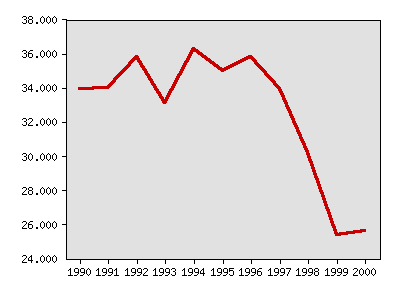What were things like in 2002?
The following idicator summary is from the 2002 Minnesota Milestones and does not neccessarily reflect the current data trends.Indicator : Juvenile apprehensions
Rationale: Youth crime is an important factor in community safety. Youth commit a disproportionate share of violent crimes in Minnesota, especially serious property crimes.
About this indicator: Youth apprehensions rose in the early 1990s but have been decreasing since about mid-decade, despite the fact that the youth population has been growing steadily. The rate of apprehensions per 1,000 youth dropped from 35.7 in 1996 to 25.6 in 2000.
Arrests of juveniles are called apprehensions. This rate includes violent crime and property crime (burglary, larceny, motor vehicle theft and arson). In 1999, youth age 10-17 committed 43 percent of all violent and serious property crimes in Minnesota, according to the Department of Public Safety.
The apprehension rate is a different measure than the crime rate. The age of the perpetrator is not available for every crime, only for those that result in an apprehension or arrest. Also, a single apprehension may cover several offenses.
Apprehensions of youth for violent crime and serious property crime, per 1,000 youth ages 10-17

| Year | Data |
|---|---|
| Apprehensions of youth for violent crime and serious property crime, per 1,000 youth ages 10-17, Minnesota Department of Public Safety | |
| 1990 | 33.9 |
| 1991 | 34.0 |
| 1992 | 35.8 |
| 1993 | 33.1 |
| 1994 | 36.3 |
| 1995 | 35.0 |
| 1996 | 35.8 |
| 1997 | 33.9 |
| 1998 | 30.2 |
| 1999 | 25.4 |
| 2000 | 25.6 |
For comparison: In 2000, the national total (violent and property crimes) apprehension rate was 12.4 apprehensions per 1,000 youth (ages 10 to 17), compared to 22.5 in Minnesota. However, the national data is collected by the Federal Bureau of Investigation (FBI), a different source than the Minnesota data reported here, and the two sources collect their data at different times of the year, making comparison difficult.
Things to think about: More populous counties tend to have higher youth apprehension rates, but several smaller rural counties also have high rates. For example, Koochiching County had 50.3 apprehensions and Nobles County had 44.1 apprehensions per 1,000 youth in 2000. Youth apprehension rates in Hennepin and Ramsey counties were 38.6 and 40.8 respectively.
Technical notes: National juvenile apprehension data is collected by the Federal Bureau of Investigation (FBI), a different source than the Minnesota juvenile apprehensions data included in this report. Collection dates for the two sources are at different times of the year, making comparison difficult.
Sources:U.S. Department of Justice, Federal Bureau of Investigation, Crime in the United States 1999, www.fbi.gov/ucr
Minnesota Department of Public Safety, Bureau of Criminal Apprehension, www.dps.state.mn.us/bca
Related 2002 Milestones indicator:
Other related indicators:
- School children who feel safe or very safe at school (Office of the Minnesota Attorney General, Safe School Survey, www.ag.state.mn.us)
- Homicide rate (Minnesota Department of Public Safety, Minnesota Crime Information, www.dps.state.mn.us)
- Arson rate (Minnesota Department of Public Safety, Fire in Minnesota)
- Juvenile apprehensions and adult arrests by race and ethnic origin (Minnesota Department of Public Safety, Minnesota Crime Information)
Local data:
County level data:





